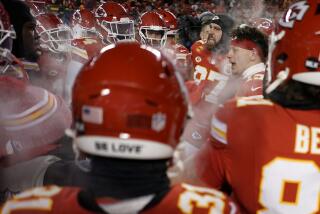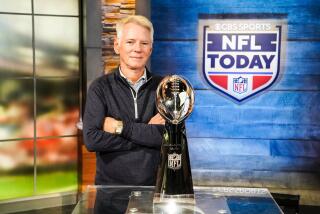On the Road to Recovery: NFL Has a Good Year
On Nov. 24, 80% of the television sets that were turned on in the Denver area between 2 p.m. and 5 p.m. were tuned to the Broncos’ game at Los Angeles against the Raiders.
The next week, the number dropped to 78% for the Broncos’ game at Pittsburgh, but it jumped to 82 percent the following week when the Raiders came to town to play for the American Football Conference West title.
Every National Football League city isn’t as gung-ho as Denver, but 1985 still has been a recovery year for the NFL.
When the regular season ends Monday night with the Los Angeles Raiders and Los Angeles Rams meeting at Anaheim, Calif., it will mark the end of a year in which America regained its football appetite.
It also has been a season in which the NFL produced just the image and personality it seemed to lack in three seasons of decline, beginning in 1982.
Was it because of the Chicago Bears and their oversized rookie William (The Refrigerator) Perry?
Was it simply the swing of the pendulum, as Commissioner Pete Rozelle implies?
Whatever it was, the gloom of 1984 has been replaced by broad smiles around NFL headquarters on Park Avenue.
The best measure, of course, is TV ratings, up 20 percent after 15 weeks on ABC’s prime-time games; and 11 percent on CBS and 5 percent on NBC after 14 weeks.
The Bears’ game at Miami Dec. 2 drew a 29.2 rating on ABC, the highest ever in the 16 years of “Monday Night Football.” There have been five ratings over 20 this season. Last year, there was only one--the 25.1 for the final Monday night game between Dallas and Miami.
Not only are people watching games, they seem to be talking about the NFL more this season, particularly the 14-1 Bears and the pudgy Perry, punk quarterback Jim McMahon, yuppie safety Gary Fencik and scholarly linebacker Mike Singletary.
And they’re not just the talk of the Windy City.
“You can talk about Perry, but from a team standpoint you need star teams and the Bears fit that, too,” said Tex Schramm, president of the Dallas Cowboys.
“When the Yankees were dominating baseball, people wanted to see them to root for them or against them,” he said.
That’s exactly what happened in Miami, where the Bears recently suffered their only loss of the season. The hype that preceded the game was unheard of in a city where Dolphins’ victories are taken matter-of-factly.
Newspapers in Chicago and Miami carried full-page ads supporting their respective teams. One TV station sent a reporter to the zoo and seaquarium to “interview” dolphins and bears about the upcoming contest.
Could the NFL buy better publicity?
Not only was that game’s popularity reflected in the TV ratings, but inside the packed Orange Bowl. The 75,594 fans yelled so loudly and effectively that the game was held up nearly 10 minutes because the Bears couldn’t hear signals.
One explanation for the NFL’s success this season is successful teams in major media markets--Boston, New York, Chicago and Los Angeles. When the Patriots went to Florida a week early to prepare for last Monday’s AFC East title showdown with Miami, the hosts of a radio talk show went with them.
Another is the lack of problems that plagued the NFL the past three years. In 1982, there was the strike that cut the season to nine games; in 1983, the strike hangover; and in 1984, the bidding war by the United States Football League that sapped a lot of the NFL’s strength and distracted the public.
The USFL currently is in hiatus after switching to a fall season, and many of its stars have jumped to the older league.
A third reason may simply be a more fortunate schedule that has set up important Monday night games such as Bears-Dolphins, Rams-49ers, Patriots-Dolphins and Broncos-49ers.
“That’s true, there have been good matchups,” said Val Pinchbeck, the NFL’s director of broadcasting. “But we’ve had them in other years. More important, these games have been competitive, even when the matchups haven’t been attractive. In the last two or three years we had been snakebit even when the games were close.”
A fourth reason could be Rozelle’s cycle theory--that after a decline in TV ratings it was time for the NFL to bounce back. It’s all cyclical, he said.
And a fifth? It’s all in the perception. That’s Schramm’s theory.
“I don’t think there was ever a time when people weren’t interested,” Schramm said. “It just wasn’t being reported right. All sports were down, all prime-time television was down and I don’t think there was any big exodus out of the living room watching football. I think that somewhere along the line, they weren’t getting the right figures.”
More to Read
Go beyond the scoreboard
Get the latest on L.A.'s teams in the daily Sports Report newsletter.
You may occasionally receive promotional content from the Los Angeles Times.










